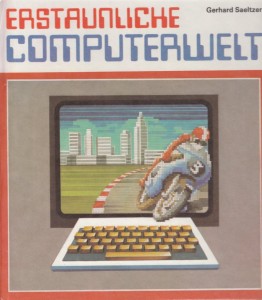
A short time ago, Roland Dürre came with a pile of books – masses of well-preserved copies of Gerhards Saeltzer’s „Erstaunliche Computerwelt (Amazing Computer World)”.
Roland’s comment: “I am going to buy up all the copies of this book on the market. With this book, we will be able to turn even the very young talents towards computer science”.
I must admit that, on seeing the somewhat yellowed cover page, I found the idea a little absurd. But as the two of us started turning page after page with smiles on our faces, we made some most amazing discoveries. Listed as they sprang to mind, they are:
1. There is not all that much that changed over the years
Even pen control and language recognition are written about in this book of 1988.
Even though the pictures have a kind of nostalgical charme and were printed in the GDR, they give you the same impression you get on, perhaps, seeing some old tin toys: not modern, but lovable. And in this case, there is a true utility value. Our next idea was:
2. It is still quite possible to understand computers from scratch.
The modern lament that there used to be a time when you could understand everything from microchips to the application program is understandable. And, of course, today there are masses of complex finesses that only specialists can grasp. Yet the basic connections of the different IT layers can still be quite well understood, even by “readers up from 12 years of age”, as the cover text states in a way that is both touching and encouraging. Consequently:
3. Experience makes you wise, but sometimes it also makes you blind.
For those among us who digged deep into the intricacies of JEE and .Net, too, a short pause for reflection on the roots might be relaxing. You can see the simple principles and their effect in practical life: in the end, it all comes down to just Zeros and Ones, but they can have a huge effect.
Eventually, I decided to take one copy home for a simple practical test on my offspring. The comment of the junior staff came down to: “What an ancient-looking cover page” – pause, page-turning, forehead-wrinkling, smiles, and continued browsing- “… but the inside is really cool”.
What else can anybody expect!
CST
(Translated by EG)
Comment by Roland Dürre:
We found the book in September 1990 when we had an InterFace event in Dresden (immediately after the re-unification). The author had organised the “First German-German Conference on Modern Software and Computer Systems SoftSys” with InterFace. I will report separately about what InterFace did there and describe our experiences.
I liked the book very much, because it describes computer science in a colourful way. You also understand the basis of computer science well on reading it. Besides, there is some depth to it I sometimes sadly miss among computer science graduates.
